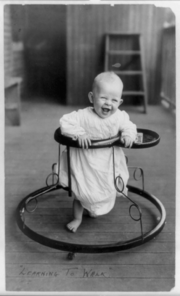
Baby walker
Encyclopedia

Infant
A newborn or baby is the very young offspring of a human or other mammal. A newborn is an infant who is within hours, days, or up to a few weeks from birth. In medical contexts, newborn or neonate refers to an infant in the first 28 days after birth...
s who cannot walk
WALK
WALK may refer to:*WALK , a radio station licensed to East Patchogue, New York, United States*WALK-FM, a radio station licensed to Patchogue, New York, United States...
on their own to move from one place to another. Patents have been issued for baby walkers as early as 1851. Modern baby walkers have a base made of hard plastic sitting on top of wheels and a suspended fabric seat with two leg holes. A baby walker often has toy
Toy
A toy is any object that can be used for play. Toys are associated commonly with children and pets. Playing with toys is often thought to be an enjoyable means of training the young for life in human society. Different materials are used to make toys enjoyable and cuddly to both young and old...
s attached to the top to entertain the baby. It is designed for a child between 4 and 16 months.
Safety Issues
Many parentParent
A parent is a caretaker of the offspring in their own species. In humans, a parent is of a child . Children can have one or more parents, but they must have two biological parents. Biological parents consist of the male who sired the child and the female who gave birth to the child...
s believe that such walkers teach a child to walk faster; however, studies suggest that it is not true, and they may actually delay walking by two to three weeks. These devices have also led to many injuries. In fact, CPSC
Consumer Product Safety Commission
The United States Consumer Product Safety Commission is an independent agency of the United States government created in 1972 through the Consumer Product Safety Act to protect "against unreasonable risks of injuries associated with consumer products." The CPSC is an independent agency that does...
, American Academy of Pediatrics
American Academy of Pediatrics
The American Academy of Pediatrics is the major professional association of pediatricians in the United States. The AAP was founded in 1930 by 35 pediatricians to address pediatric healthcare standards. It currently has 60,000 members in primary care and sub-specialist areas...
and other organizations have issued warnings to discourage parents from using baby walkers.
In Canada
Canada
Canada is a North American country consisting of ten provinces and three territories. Located in the northern part of the continent, it extends from the Atlantic Ocean in the east to the Pacific Ocean in the west, and northward into the Arctic Ocean...
, the sale of baby walkers was banned on April 7, 2004. Canada is the first country in the world to ban the sale, importation and advertisement of baby walkers. This ban extends to modified and second hand baby walkers, including those sold at a yard sale or flea market
Flea market
A flea market or swap meet is a type of bazaar where inexpensive or secondhand goods are sold or bartered. It may be indoors, such as in a warehouse or school gymnasium; or it may be outdoors, such as in a field or under a tent...
s. The Consumers Product Safety Improvement Act of 2008 (CPSIA) changed the items that were allowed to be sold at such sales. Owners of baby walkers may be fined up to $100,000 or sentenced to up to six months in jail.
History
Baby walkers superseded the previous technology, which was leading stringsLeading strings
Leading strings are strings or straps by which to support a child learning to walk. In 17th and 18th century Europe, they were narrow straps of fabric attached to children's clothing which originally functioned as a sort of leash to keep the child from straying too far or falling as they learned...
. Before the invention of baby walkers, leading strings (strings or strong ribbons attached to the child's clothes) were used to restrain children in safe areas, such as away from cooking fires, and to reduce the number of times they fell while learning to walk. In this second use, the leading strings were held up by an adult, rather than holding the child's hands over his head, or requiring the adult to stoop.
Parent-Assisted Baby Walkers
Parent-assisted baby walkers were developed as an alternative to traditional baby walkers. These types of baby walkers differ greatly from traditional baby walkers as they require full parent assistance while in use. The design of modern parent-assisted baby walkers is similar to leading stringsLeading strings
Leading strings are strings or straps by which to support a child learning to walk. In 17th and 18th century Europe, they were narrow straps of fabric attached to children's clothing which originally functioned as a sort of leash to keep the child from straying too far or falling as they learned...
in that the child is suspended upright while learning to walk. Parent-assisted baby walkers offer a safer method for teaching a child to walk over traditional baby walkers that can be unattended while in use.

